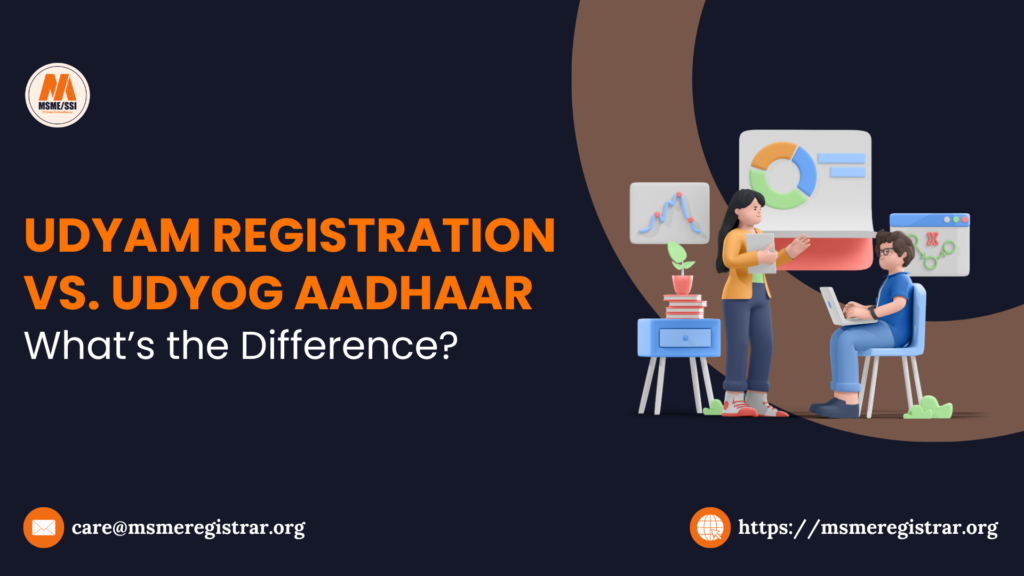The Indian government has long recognized the need to support small and medium enterprises (SMEs) as crucial drivers of economic growth and employment. To facilitate this, the government introduced several registration systems for SMEs over time, including the Udyog Aadhaar Memorandum (UAM) and, more recently, the Udyam Registration. While both aim to help businesses receive benefits and recognition, they differ significantly in their processes, criteria, and the advantages they offer. This article will break down the key differences between Udyam Registration and Udyog Aadhaar, helping business owners understand which system is relevant to them and why the shift was made.
Understanding Udyog Aadhaar
Udyog Aadhaar was introduced by the Ministry of Micro, Small, and Medium Enterprises (MSME) in 2015 to make it easier for SMEs to register and access various government schemes and incentives. Prior to its launch, MSME registration was a complex process that often deterred small business owners from formally registering their enterprises. Udyog Aadhaar simplified this by allowing businesses to self-certify their information, making the process more straightforward and user-friendly.
Introduction of Udyam Registration
On July 1, 2020, the Indian government replaced Udyog Aadhaar with Udyam Registration as part of its efforts to streamline and modernize the MSME registration process. The shift came as a response to the limitations and issues businesses faced under Udyog Aadhaar, such as incomplete data verification and challenges in accessing government schemes.
Udyam Registration is a more structured and data-driven system that emphasizes accurate business classification and ease of access to government benefits. The Ministry of MSME adopted this system to provide a more reliable framework for business support.
Key Features of Udyam Registration
- Automated Verification: Unlike Udyog Aadhaar, which relied on self-certification, Udyam Registration integrates data from various government databases such as GST (Goods and Services Tax) and PAN (Permanent Account Number). This ensures more accurate verification of business details.
- Mandatory PAN and GST: Udyam Registration mandates the use of PAN and GST numbers for businesses. This is a crucial shift from Udyog Aadhaar, where providing a PAN was optional. This change ensures better traceability and categorization of businesses.
- Paperless Process: The Udyam Registration system is fully online, eliminating the need for any paperwork or physical submission of documents. The registration process is based on data retrieval from government databases.
- Updated Business Classification: Udyam Registration redefined the classification criteria for MSMEs, based on a combination of investment in plant and machinery/equipment and turnover. This is in contrast to Udyog Aadhaar, which only considered investment for classification.
- Integrated with Other Government Databases: The new system allows for better coordination between government agencies and ensures that businesses registered under Udyam can seamlessly access benefits from various government schemes without repeatedly providing their details.
- Unlimited Registrations: Unlike Udyog Aadhaar, where multiple units could be registered under a single Aadhaar number, Udyam requires separate registrations for each enterprise. This ensures that each business is treated as a distinct entity, which is important for accurate classification and benefit allocation.
Udyog Aadhaar vs. Udyam Registration: Key Differences
1. Registration Process
- Udyog Aadhaar: It was a simpler process, relying on self-declaration and requiring minimal documentation. Business owners could register with their Aadhaar number and basic business details.
- Udyam Registration: It has introduced a more formalized process that requires PAN and GST verification, making it more aligned with the government’s digital infrastructure.
2. Verification and Authenticity
- Udyog Aadhaar: The system relied on the honesty of the business owner, as no documents were required upfront. This sometimes led to discrepancies and misuse.
- Udyam Registration: This new system emphasizes authenticity through integration with PAN and GST systems. It uses government databases to verify the information provided by the business, minimizing the chances of false or incomplete data.
3. Business Classification Criteria
- Udyog Aadhaar: Classification was based solely on the investment in plant and machinery or equipment.
- Udyam Registration: The classification now includes both investment in plant and machinery/equipment and annual turnover. This provides a more comprehensive view of the business and its scale.
4. Government Benefits
- Udyog Aadhaar: Businesses registered under Udyog Aadhaar were eligible for various government schemes, but the verification process was often inefficient due to the lack of data integration.
- Udyam Registration: By using integrated government data, businesses can more easily and efficiently access MSME benefits. These include credit facilities, tax incentives, and subsidies.
5. Data Accuracy and Transparency
- Udyog Aadhaar: Since there was no document submission required, the accuracy of the data provided by businesses was not always guaranteed.
- Udyam Registration: By relying on PAN and GST data, the Udyam system ensures a higher level of accuracy and transparency in the business registration process.
6. Ease of Doing Business
- Udyog Aadhaar: While Udyog Aadhaar significantly simplified the earlier MSME registration process, it still had limitations in ensuring businesses had access to the full range of government support due to its lack of integration with other government systems.
- Udyam Registration: Udyam is a step further in enhancing the ease of doing business in India. Its seamless integration with multiple government databases ensures that businesses can focus on growth rather than dealing with bureaucratic hurdles.
Also Read, How to Download MSME Certificate?
Conclusion
While Udyog Aadhaar played a significant role in simplifying MSME registration, Udyam Registration represents the next step in the government’s efforts to support SMEs more effectively. The new system’s reliance on digital databases ensures greater transparency, accuracy, and ease of access to benefits. For business owners, transitioning to Udyam Registration is not just a matter of compliance; it’s an opportunity to be part of a more streamlined and supportive business ecosystem.
